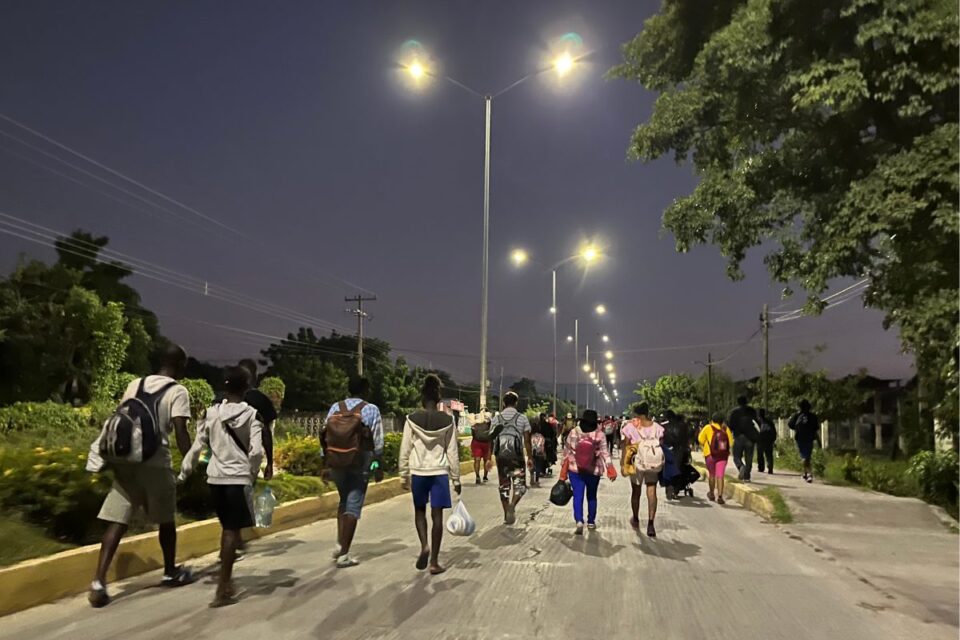‘We Need a Little Rage’ in the Media
Alleged Witnesses to Reporter’s Killing Again Fail to Show
Homepage photo: Asylum seekers begin their trek into the dangerous Darién Gap in Panama (Credit: Yurema Perez-Hinojosa/Latino USA)
Journal-isms Roundtable photos by Sharon Farmer/sfphotoworks
.
‘We Need a Little Rage’ in the Media
Zita Arocha (photo, below), who edits Borderzine, covering the southern border, recalls flying to Austin, Texas, seated next to a migrant from Venezuela who had been processed at a U.S. detention center.
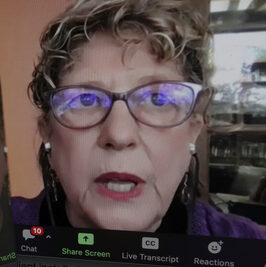 The woman had been in Peru for two years, and with other asylum seekers, had crossed the treacherous Darién Gap in Panama, between Central and South America. “She made it to the border. She got to El Paso, and she was on her way to meet her husband, who was also Venezuelan, who was already in Miami, and had been in Miami for two years,” Arocha said.
The woman had been in Peru for two years, and with other asylum seekers, had crossed the treacherous Darién Gap in Panama, between Central and South America. “She made it to the border. She got to El Paso, and she was on her way to meet her husband, who was also Venezuelan, who was already in Miami, and had been in Miami for two years,” Arocha said.
“And she described to me . . . [it] is very dehumanizing to people to go through that detention process. And she was telling me that one of the first things that Immigration did is they had them dump all of their possessions — whatever, every single thing that they brought, in trash bins. . . including what they were wearing in their shoes.
“They were given, you know, new clothes and new shoes to wear.
“And so, the question is, why are they doing that? . . .
“Is it because of COVID? is it because of fear of disease?
“I don’t know, and that’s something I wish that some journalist would go out there and report. . . .
“Some people hide their papers, but then, you know, they have to take off their clothes, and even that is basically thrown in the bin, so that when they get here, they are stripped of all personal identity. And to me that is inhuman.”
On Facebook, Todd Steven Burroughs, a writer and public historian, was watching Arocha speak at this Journal-isms Roundtable titled, “What about the Black and Asian asylum seekers? and other undercovered immigration stories.”
Burroughs wrote, “This was a great forum but I think we need a little rage and a lot of planning! We have several organizations that can raise hell and an entire World Wide Web to fill with text, audio and video, right? 🙂”
Those comments dovetailed with what many were saying in this Zoom conversation. The revelations about how immigrants are treated should be generating outrage. The immigration story is as much about human beings as it is policy. But the human side often gets short shrift.
“It’s similar to the treatment in a recent ‘Law and Order’ episode in which a white supremacist shoots Asian looking people on a 6 subway train in NYC and aside from interviewing a victim about what she saw, it turned into a yarn about white supremacy, hate crimes, and the death penalty,” Ivan Roman, a former executive director of the National Association of Hispanic Journalists, wrote, also watching on Facebook. “Some of the coverage would go along that path and not deal with the immigrant or human story at all.”
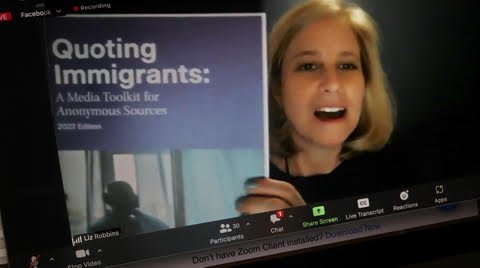 As panelist Liz Robbins (pictured) of the group Define American said, “I hate to be the cynical journalist, but the more we can humanize what’s going on and pull out the contrast, the more people will understand this.”
As panelist Liz Robbins (pictured) of the group Define American said, “I hate to be the cynical journalist, but the more we can humanize what’s going on and pull out the contrast, the more people will understand this.”
The Roundtable was held on a Sunday afternoon, Nov. 20, with 34 people participating by Zoom, another 58 having watched on Facebook by Nov. 30, and 46 viewing on YouTube by that date. You can watch here or view the embedded version above.
The news media are very much part of the story. They have the means to highlight abuses despite lack of access to key parts of the drama. But they are too often complicit with authorities or disinterested in a more complete picture.
Jeff Migliozzi represents a group called Freedom for Immigrants, which issued a report with other Black immigrant advocacy groups in October that, they said, indicates a pattern of racism and abuse toward Black migrants.
Migliozzi, the group’s communications manager, noted in the Roundtable’s chat room, “In my experience working with reporters and ICE [U.S. Immigrations and Customs Enforcement] to arrange visits, ICE typically denies reporter visits, but will overtimes reach out on their own to local media to trade access for a puff piece (typically following a period of negative media attention). So local media are oftentimes more likely to have visits.”
Migliozzi provided another example: Coverage of abuse at the Baker County Detention Center near Jacksonville, Fla.
“We filed, like, a major civil rights complaint on behalf of a lot of people at Baker, and there was a lot of . . . national media attention from ABC News, NBC News, and even a lot of the local papers. But the local media, specifically the TV stations are very favorable to ICE, and the sheriff’s narratives.
“And so I saw that a lot of the . . . national reporters were denied access to, you know, going inside the facility and interviewing people.
“But then we saw the sheriff actually reached out to a local news reporter, and they did a piece that was extremely one-sided and didn’t actually interview anyone that, was you know, in the complaints. . . .”
What would journalists see if they had free rein? Racism and abuse, we were told.
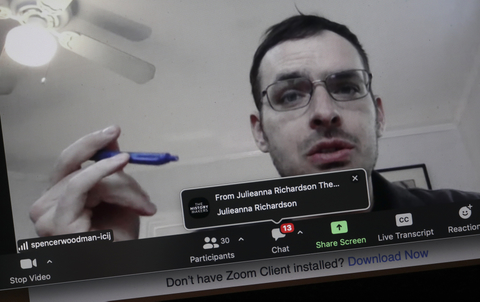 Spencer Woodman (pictured) was lead writer for “Solitary Voices,” a 2019 report on solitary confinement in ICE facilities for the International Consortium of Investigative Journalists and six media partners.
Spencer Woodman (pictured) was lead writer for “Solitary Voices,” a 2019 report on solitary confinement in ICE facilities for the International Consortium of Investigative Journalists and six media partners.
“Anti-Black racism combined with a detainee’s language disadvantage looked like a particularly toxic mix from my conversations with detainees,” Woodman said.
“I spoke with Punjabi men, Afghan men, people from Africa and Haiti, who described a situation where . . . a population that was a plurality or a majority within the detention center was Spanish speaking. And that the Latinx population . . . were suffering hardships themselves in detention, but they did have that lifeline of being able to speak the language that a lot of the guards spoke. A lot of ICE guards are Latinx themselves or Spanish speaking.
“And they would describe what they almost saw in some cases — not to generalize at all, or minimize how terrible the situation is for a lot of Spanish-speaking detainees, but in some cases, you know, there’s almost a camaraderie between detainees and guards — some of these people who didn’t speak Spanish, and they were not Latinx, felt that they were utterly scorned by guards. . . . And you see this anecdotally, with some of the worst treatment of detainees often being people who are not Spanish-speaking or of a different ethnicity. . . .
“And yeah, you don’t hear about white detainees getting treated badly, either.”
Woodman continued: “But one case outside solitary confinement was a 2018, or maybe it’s [a] 2017 flight, that was where Somalis were shackled and abused, and kept on this flight for 40 hours under tightly — no access to food or water or bathrooms, absolutely terrible.
WJXT-TV in Jacksonville, Fla., reports this summer on civil rights groups’ allegations against the Baker County Jail. (Credit: YouTube)
“So you know, a lot of the people I spoke with did have this feeling that they had been put in solitary confinement because the guards disliked them, and that there was the strong racial or ethnic or language reason for that. The Punjabi men I spoke with couldn’t speak English or Spanish, and so there’s this additional failure to communicate that can cause them to actually just break rules by accident, and then not be able to explain themselves.
“And, you know . . . there’s so much kind of nuance there . . . the nuance in terms of the racial categories being a little different than you’re used to in media coverage, and it’s something that I found fascinating. I wished we could have . . . dove into [it] a little more. There’s . . . some scholarship on it, but not a ton of great stuff.
“That’s highly anecdotal, but the extent to which Black and the Asian Middle Eastern people I spoke with in detention were discriminated against was very striking to me.”
They are two sides of the same deficiency: Undercovered immigration stories and sparse coverage of Black and Asian asylum seekers, the other main topic on the agenda.
On Veterans Day, just about a week before the Roundtable, the issue of Black immigrants surfaced at a “national town hall” at Howard University. Co-moderator Roland Martin noted that immigrants represent 10 percent of the U.S. Black population and help bolster the clout of African Americans when authorities create voting districts. Yet, said E. Faye Williams, president of the National Congress of Black Women, African Americans have been taught that immigration “has nothing to do with us.”
Arocha said that African-born immigrants represent the fastest growth among Black immigrants, though still second to those born in the Caribbean. “In North Carolina we found that Nigerian immigrants were the biggest population from Africa. Congolese refugees are one of the largest refugee groups,” Robbins added.
Interactions along the border with Mexico have changed.
Arocha said of the 1.7 million apprehensions in 2020, more than a million involved people who didn’t hail from Mexico. “That includes folks from Africa, India, and most recently Ukrainians coming to the border because they can’t go through our legal refugee system,” she said. “Cubans as well.”
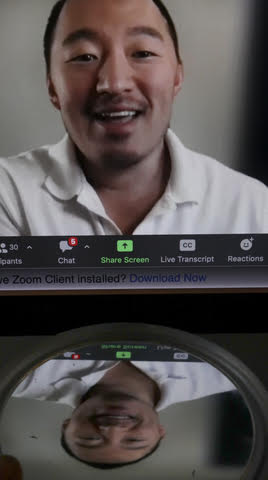 Kham S. Moua, national deputy director of the Southeast Asia Resource Action Center, observed that limited media coverage doesn’t reflect the diversity of Asian Americans – let alone Pacific Islander populations. That means more than 50 different ethnic identities. Moua said refugee stories are going untold, even in places like Minnesota (5.5 percent Asian-Pacific Islander) and Iowa (3 percent), which have larger numbers of such refugees.
Kham S. Moua, national deputy director of the Southeast Asia Resource Action Center, observed that limited media coverage doesn’t reflect the diversity of Asian Americans – let alone Pacific Islander populations. That means more than 50 different ethnic identities. Moua said refugee stories are going untold, even in places like Minnesota (5.5 percent Asian-Pacific Islander) and Iowa (3 percent), which have larger numbers of such refugees.
“Asian Americans speak over 100 different languages, and they have various migratory histories and experiences that result from it,” Moua said.
Moua called attention to the Trump-era ban on immigration from an entire country — Laos — as a huge story that he said deserved more attention. The ban was largely seen as a retaliatory measure used to pressure Laos into accepting more deportees. President Biden lifted most of the sanctions in February.
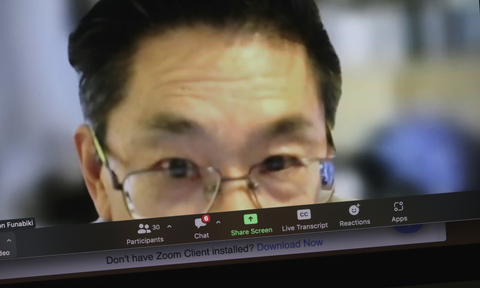 Jon Funabiki (pictured), retired professor at San Francisco State University and veteran of the journalism diversity movement, added that in the case of the Atlanta spa slayings of 2021, “the local Korean ethnic newspapers and broadcast reporters were often way ahead, and more accurate, than the mainstream news outlets. So, collaboration with ethnic media of all kinds would be helpful for journalists.”
Jon Funabiki (pictured), retired professor at San Francisco State University and veteran of the journalism diversity movement, added that in the case of the Atlanta spa slayings of 2021, “the local Korean ethnic newspapers and broadcast reporters were often way ahead, and more accurate, than the mainstream news outlets. So, collaboration with ethnic media of all kinds would be helpful for journalists.”
Those spa killings provided a missed opportunity to connect COVID-inspired anti-Chinese sentiments with anti-immigrant feelings and anti-Asian American actions, regardless of whether the targets were Chinese, Moua said.
Robbins’ research for Define American backs Moua’s observations. Her study of immigration coverage in North Carolina showed “that while Latinx communities dominated, news outlets severely neglected Asian American and Pacific Islander communities.” Robbins, director of journalism partnerships for the group, founded by former reporter Jose Antonio Vargas, said in the report, “They represent nearly a third of all immigrants in the state (compared to the half that are Latinx), but were only featured in less than 5% of news stories.”
The October study, “Reimagining Immigration News: North Carolina’s Case for the Nation,” cited research from the Media Ecosystems Analysis Group.
Of nearly 300 news outlets, just three reporters focused on immigration, she added.
“Consistent coverage of immigrant communities matters because of the prevailing misinformation that news consumers receive about immigrants. The University of Florida’s Center for Public Interest Communications conducted a survey of 1,160 North Carolinians for our report. Those who said they knew the most about immigration actually knew the least – and were most likely to believe harmful stereotypes.
“We found, however, that good journalism can help shift those perspectives.
“The way a story is framed makes a difference. Integrating immigration, coverage into relatable topics like sports or business encourages broader audience.”
The last line in an accompanying video report drove home the point: “Covering immigrants is not only the job of immigration reporters, it’s the job of every reporter.”
Robbins said people – the human element – are at the heart of immigration coverage, just like they
were at the heart of her old beat, sports coverage. “It’s trying to find out who the people are behind the
statistics. … You’re trying to understand your community; that’s what local news is all about.”
Other suggestions from attendees:
- Seek access to detainees. “I’m sure most of you know that it is nearly impossible for journalists to get into detention centers to report on what’s happening in there, right?,” said Arocha. “And especially when it was and still is with the children, undocumented children that are younger than 15. . . .
“I think the ACLU does have access. Sometimes a reporter can go in with a lawyer who may be representing a somebody who’s in detention, but, as Liz said, many of these people are not even given the opportunity to seek representation, they don’t know what to do.”
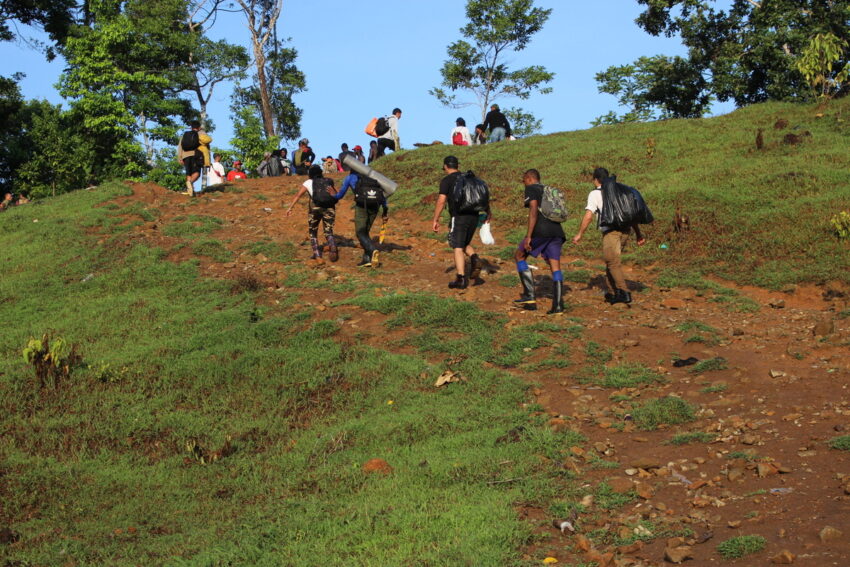
- Work with local press groups. Diana Fuentes, executive director of Investigative Reporters and Editors, said that while she would like to see more involvement by national organizations, “working at the local level seems to be the way to go. If you knew the prosecutors, if you knew someone . . . establishing relations makes a difference, even though they’re, you know, with the government, if they could quote unquote, trust you, if you will, but would be willing to fight for you.”
- Conduct Zoom sessions and webinars. Rebecca Aguilar, immediate past president of the Society of Professional Journalists, said, “It’s important to constantly have Zoom sessions where we educate those local reporters, because on the local level you’ll see them come and go, much because they’re burnt out . . . They’re having to do more with less, less pay, they have to cover more stories. And yeah, it’s easy for them to do a story where someone’s handing them everything, like the immigration officials, than having to fight for it. Right?
“So I think what is key is that many of the organizations, whether it’s SPJ, NAHJ, NABJ, IRE, that we constantly need to be having these educational forums where we teach especially the younger Journalists who are heading into this immigration journey to learn how to do it, and watch out for those people who are trying to use you as a puppet instead of an informer.” The acronyms are for the Society of Professional Journalists, the National Association of Hispanic Journalists, the National Association of Black Journalists, and Investigative Reporters and Editors.
- Pay attention to the Biden administration. Joel Dreyfuss, a Haitian native who went on to become a co-founder of the National Association of Black Journalists and an accomplished writer and editor, cited reports that the administration is considering once again sending Haitians to Guantanamo Bay, “which has been used to keep people out of the reach of the legal system.” He said the administration’s continuation of Trump policies has proceeded in part because of “a press that’s not as demanding of the Biden administration to be accountable. Agreeing with Robbins that the positive contributions of immigrants must be publicized, Dreyfuss noted that Henri Ford, dean of the University of Miami Miller School of Medicine, is just one Haitian-American at the top levels of academia. (The Miami Herald reported Tuesday, “Migrants interdicted at sea attempting to enter the United States are typically repatriated to their home country. But if the migrant expresses fear at the prospect of being returned, they can be brought to Guantánamo, where USCIS agents conduct ‘well-founded fear’ interviews, work on their case and identify next steps, a U.S. official said.”)
- Follow the work of Sen. Jon Ossoff, D-Ga., chair of the Senate Homeland Security and Governmental Affairs Committee’s permanent subcommittee on investigations. This bipartisan group reported Nov. 15 that “Women held at a privately run immigration jail in Georgia were probably subjected to unnecessary gynecological procedures, and Immigration and Customs Enforcement authorities did not halt a years-long pattern of what medical experts called’ aggressive and unethical’ treatment, Maria Sacchetti and Nick Miroff wrote for The Washington Post.’
The Roundtable began with a presentation from Julieanna L. Richardson, founder and president of The HistoryMakers, and congratulated Claire Regan, new president of the Society of Professional Journalists.
Richardson said the 22-year-old nonprofit, which has videotaped more than 3,330 interviews and 80 special events, has become “the digital repository for the Black experience with narrative storytelling at our core.
“We’ve grown to be the largest collection of African American video oral history interviews, and a primary research data set,” Richardson said, making it the largest such project since the WPA Slave Narratives in the 1930s. In 2014, the Library of Congress became The HistoryMakers’ permanent repository.
Richardson put out a call for those who might want to conduct oral histories for her Chicago-based organization.
Contributing: Deron Snyder
- Ayodeji Adegboyega, Premium Times, Nigeria: New opportunities for ‘fleeing’ Nigerians as Canada targets 1.45 million immigrants by 2025 (Nov. 2)
- Farah Bahgat, Deutsche Welle: EU asylum applications reach ‘new high’ since 2015 (Nov. 9)
- Ryan Devereaux, the Intercept: Journalists, Lawyers, and Activists Working on the Border Face Coordinated Harassment From U.S. and Mexican Authorities (Feb. 8, 2019)
- Susan Hartman, Beacon Press: City of Refugees: The Story of Three Newcomers Who Breathed Life Into a Dying American Town (June 7)
- U.S. Rep. Pramila Jayapal, D-Wash., Sen. Cory Booker, D-N.J., and U.S. Rep. Adam Smith, D-Wash.: Reintroduction of Dignity for Detained Immigrants Act
- Stef W. Kight, Axios: Scoop: Biden administration eyes border overhaul as Title 42 ends
- Tony Frangie Mawad, Politico Magazine: A Flood of Venezuelan Migrants Is Angering Other Venezuelans
- Michael Page and Minky Worden, Human Rights Watch: Qatar World Cup Chief Publicly Admits High Migrant Death Tolls
- Michael Elsen-Rooney, Chalkbeat: ‘All-hands-on-deck’: A Queens charter school welcomes 70 asylum-seeking students
- Liz Robbins, New York Times: A Light for Me in the Darkness’: For Migrant Detainees, a Bond Forged by Letter (Feb. 7, 2019)
- Julie Turkewitz, New York Times: In a Brutal Jungle, Small Acts of Kindness (Nov. 23)
- WPVI-TV, Philadelphia: Bus of asylum-seekers from Del Rio, Texas arrives in Philadelphia
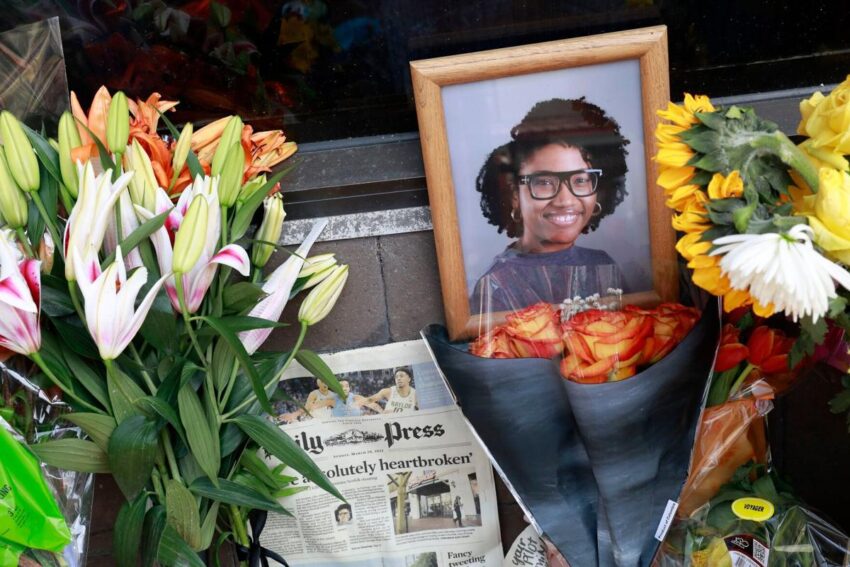
Alleged Witnesses to Reporter’s Killing Again Fail to Show
Two men believed to be witnesses in the March killing of up-and-coming Norfolk, Va., reporter Sierra Jenkins and two others failed to show up in Norfolk District Court for the second time Wednesday.
The sheriff was unable to locate the two in order to serve them the court papers, Ramin Fatehi, Norfolk commonwealth’s attorney, told Journal-isms by telephone.
Judge Michael Rosenblum set a new court date for Jan. 17, giving authorities another chance to locate the men and persuade them to appear.
“Deputy Commonwealth’s Attorney Scott Miles told Rosenblum on Wednesday the witnesses live in Portsmouth so proper procedure requires Portsmouth sheriff’s deputies to deliver the notices to them. The deputies, however, were unable to locate and serve them, Miles said,” Jane Harper reported Wednesday for the Virginian-Pilot in Norfolk.
Jenkins, an education reporter for The Virginian-Pilot and Daily Press, was one of three people killed in a March 19 shooting outside a popular nightspot in downtown Norfolk. When an editor learned early that Saturday that several people had been shot in downtown Norfolk, he called Jenkins repeatedly to ask her to cover it. But she couldn’t be reached. She had been killed there, days after her 25th birthday.
Fatehi tied the case to a reluctance in communities nationwide for witnesses to come forward in such cases, fearing retribution. He has advocated for a state Witness Protection Program.
The News & Advance in Lynchburg, Va., editorialized for action on such a program two weeks ago.
“It is both heartbreaking and infuriating that a man accused of killing three people in downtown Norfolk in March may never see the inside of a courtroom. Charges against him were dropped Nov. 1 when two witnesses failed to appear for a hearing . . .,” the paper said on Nov. 14.
“Given that this is an all-too-common occurrence, standing up an effective witness protection program in Virginia must be a top priority of the General Assembly in January. That initiative enjoys widespread, bipartisan support and it’s past time to see it done. . . .”
Support Journal-isms
To subscribe at no cost, please send an email to journal-isms+subscribe@groups.io and say who you are.
Facebook users: “Like” “Richard Prince’s Journal-isms” on Facebook.
Follow Richard Prince on Twitter @princeeditor
Richard Prince’s Journal-isms originates from Washington. It began in print before most of us knew what the internet was, and it would like to be referred to as a “column.” Any views expressed in the column are those of the person or organization quoted and not those of any other entity. Send tips, comments and concerns to Richard Prince at journal-isms+owner@
View previous columns (after Feb. 13, 2016).
View previous columns (before Feb. 13, 2016)
- Diversity’s Greatest Hits, 2018 (Jan. 4, 2019)
- Book Notes: Is Taking a Knee Really All That? (Dec. 20, 2018)
- Book Notes: Challenging ’45’ and Proudly Telling the Story (Dec. 18, 2018)
- Book Notes: Get Down With the Legends! (Dec. 11, 2018)
- Journalist Richard Prince w/Joe Madison (Sirius XM, April 18, 2018) (podcast)
- Richard Prince (journalist) (Wikipedia entry)
- February 2018 Podcast: Richard “Dick” Prince on the need for newsroom diversity (Gabriel Greschler, Student Press Law Center, Feb. 26, 2018)
- Diversity’s Greatest Hits, 2017 — Where Will They Take Us in the Year Ahead?
- Book Notes: Best Sellers, Uncovered Treasures, Overlooked History (Dec. 19, 2017)
- An advocate for diversity in the media is still pressing for representation, (Courtland Milloy, Washington Post, Nov. 28, 2017)
- Morgan Global Journalism Review: Journal-isms Journeys On (Aug. 31, 2017)
- Diversity’s Greatest Hits, 2016
- Book Notes: 16 Writers Dish About ‘Chelle,’ the First Lady
- Book Notes: From Coretta to Barack, and in Search of the Godfather
- Journal-isms’ Richard Prince Wants Your Ideas (FishbowlDC, Feb. 26, 2016)
- “JOURNAL-ISMS” IS LATEST TO BEAR BRUNT OF INDUSTRY’S ECONOMIC WOES (Feb. 19, 2016)
- Richard Prince with Charlayne Hunter-Gault, “PBS NewsHour,” “What stagnant diversity means for America’s newsrooms” (Dec. 15, 2015)
- Book Notes: Journalists Follow Their Passions
- Book Notes: Journalists Who Rocked Their World
- Book Notes: Hands Up! Read This!
- Book Notes: New Cosby Bio Looks Like a Best-Seller
- Journo-diversity advocate turns attention to Ezra Klein project (Erik Wemple, Washington Post, March 5, 2014)
When you shop @AmazonSmile, Amazon will make a donation to Journal-Isms Inc. https://t.co/OFkE3Gu0eK
— Richard Prince (@princeeditor) March 16, 2018

